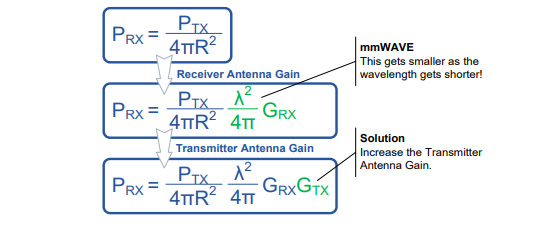5G Massive MIMO and Beamforming[Analog ,Digital,Hybrid]
A key part of the 5G NR system relates to the use of Massive MIMO (Multiple Input Multiple Output). The term “Massive MIMO” relates to an antenna array system using a “Massive” amount of antenna elements that can serve multiple users simultaneously. Typically, the number of antenna elements is 128 or 256.
How MIMO can compansate issue in 5G
So BW is more in 5G for mmWave , so by increasing mimo loss of penetration can be compansated and mimo increment possible in higher frequency as antenna length became smallerFrom above formula its clear that Prx is directly proportional to Square of wavelength and Gain of receiver and transmiter .
How MIMO Can increase capacity
From above shannon hartly theorem there are 3 component can impact Capacity
Increase
Channels
(MIMO):-Utilizing SM (Spatial Multiplexing) enables multiple streams within the
same RB (Resource Block). System requires CSI (Channel State
Information)
Increase
Bandwidth:-Existing frequency spectrum is already saturated. mmWave is
required for greater bandwidth options
Increase S/N:- Since log2 (1+S/N) this has less impact
Beamforming
Beamforming, as its name suggests is the “forming” of a “beam” of RF energy.
Fundamentally, the electromagnetic wave radiation pattern from a system is
focused like a beam from a torch (or laser)
Create a beam:- The easiest method to create a beam is to place multiple antennas in an
“array”.
As no of antenna elemrnt increased beams becoming narrow
Basic concept of how the electromagnetic waves
are reinforced in the main beam direction. This is typically termed the main
lobe. It is also worth noting that the spacing between the antenna elements is
expressed in wavelengths (λ), with different spacing having a different result
Beamforming is a type of radio frequency (RF) management in which a wireless signal is directed toward a specific receiving device(Rather than sending a signal from a broadcast antenna to be spread in all directions -- how a signal would traditionally be sent ). Beamforming is applied to numerous technologies, including wireless communications, acoustics, radar and sonar
Beamforming uses multiple antennas to send out and direct the same signal toward a single receiving device
Beam-Stearing :- By changing the antenna elements’ phase, a beam can effectively
be steered
in image 5 th picture is perfrct example of beam stearing
Null-stearing:- The concept of “Null Steering” is equally as important as beam steering. This
can be illustrated by reviewing the radiation patterns which are sent from an
antenna at the same time to four spatially separate devices. The key point
relates to the fact that whist the main lobe targets the intended device, the
nulls are steered to ensure minimal interference towards other devices.
Below is actual pattern of Beaforming/Beamstearing
Beam
Sweeping:- The process of covering a spatial area utilizing a set of
beams which are transmitted/received at pre-specified intervals and
directions
The 5G NR system defines a SSB (Synchronization Signal Block). This
includes NR synchronization signals and a PBCH (Physical Broadcast
Channel)
Due to the narrow beams, it is important that the beam sweep covers both the
azimuth of the cell’s footprint, as well as the vertical footprint
Beam
Measurement:- The evaluation of the quality of
the received signal. Either at the gNB or at the device
Beam
Determination:-The selection of the suitable beam and is related to the
measurements obtained with beam measurement.
Beam
Reporting:-The procedure used by the device to
send beam quality and beam decision information
Analog BF Uses a single common RF source split among multiple antenna elements. Beam is controlled by adjusting analog phase shifters along the RF path
1. Analog BF (mmW first releases)
2. The weights are applied in the time domain after D/A conversion.
3. Same weights (beam) for an entire timeslot
4. With 2 polarizations, can do two beams per timeslot
5. Simple but inefficient use of spectrum
Digital BF Each antenna has a dedicated RF signal & path. Phases & amplitudes are digitally controlled by baseband processing
1. Digital BF (Low and Mid Band products)
2. The weights are applied in the Baseband before D/A conversion
3. Most Flexible and best performance:
4. Different Weights per frequency blocks (PRBs)
5. Different weights in the same frequency block at same time (layers)
6. Possible to transmit to several users simultaneously in different beams
Hybrid BF Combines aspects of analog & digital beamforming








Comments
Post a Comment